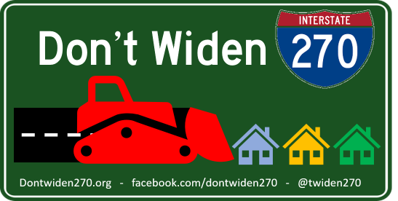Tips on Making Comments to MDOT/SHA
Thank you for your interest in making comments to MDOT/SHA on the I-495 & I-270 P3 plan. We really appreciate your participation in helping to close this project before it starts. The tips below will help you prepare the most effective communication.
First, specifically include the 2 sentences below
Your comment must include these sentences at the start. You have to be this clear to make sure they categorize your comments correctly:
I oppose the I-495 and I-270 project. I support the no-build option.
Second, detail your concerns.
These tips can guide you in developing your thoughts:
Write comments in your own voice. No copy and paste.
Speak from your heart. Be clear about your specific concerns and impacts.
Emphasize your personal 3 to 5 most concerning objections. See the list below.
Give a testimonial If you have personal experience with this kind of thing. For example:
If you live in Regents Square in Rockville (which abuts the I-270 sound walls), and you lived through the previous expansion, you might relate (1) how long it took, (2) how much disruption there was, and (3) how long it took before traffic regained its previous congestion despite the new lanes.
Keep it readable, simple language, modest length. Do not write a technical manual.
If you are technically capable and can cite specific errors or misguided conclusions in the DEIS, go for it. Make this the point of your comments.
Items You May Consider Including
Environmental: Increased air and water pollution; global climate change; localized impacts for noise, air and water quality; impacts on parks; reductions of forest canopy; controlling dust and dangerous particles during construction; impacts on schools near the highways – especially outdoor activities – need for more sophisticated air conditioning; more pavement is always bad.
Process: The pre-ordained conclusions; the rush; the lack of transparency especially for underlying data and how traffic modelling is done; surprises keep coming for example about taxpayer subsidy and WSSC subsidy for replaced infrastructure; emphasis on providing for more cars – but not enough on other solutions such as better transit and tele-commuting, Rockville the most impacted municipality was blind-sided by the state on this; the possibility that the state may seek environmental waivers (e.g., waivers on Storm Water Management facilities); how does this all get negotiated out and how are the contracts formed? ; what are the taxpayer and residential protections?;
Futility of Ever-Wider Highways: Induced demand is a well-known effect of widening highways – generate even more cars; these highways have been widened before – improvements were short lived; how are 12 existing lanes on I-270 / I-495 not enough? ; we live, work, and play next to these highways and it’s bad enough now and you want to bloat out? ; our homes and neighborhoods are right up against these highways now – there is no place to expand these roads; the streets in DC have no more capacity to accept the added traffic caused by all this.
Finance: The enormous costs will require enormous tolls; the private companies make the profit – the taxpayer bears (at least some of) the risk; the Purple Line P3 is in big trouble; the 50-year time frame for the P3 tolls far exceeds any conceivable period of reduced congestion (of at most 7 to 10 years); financial, cultural, population projections going out 50 years are impossible to make; pro-forma estimates going out 50 years are impossible to believe.
Disruption: At any one location, construction will take 4 – 5 years; in and near Rockville all bridges over I-270 have to come down and be rebuilt (Shady Grove, Gude Drive, West Montgomery, Wootton Parkway, Montrose Road, plus the bike bridge at West Montgomery); sound walls have to come down and be rebuilt; some property will be taken or otherwise impacted; WSSC and City of Rockville water or sewer pipes that go over or under or near I-270 have to be reconstructed; any utility over, under, or near I-270 may be impacted; impacts on existing stormwater management facilities is unknown and which will have to be added.
Pandemic: The pandemic will permanently change work, commuting, and development patterns; the pandemic’s long-term effects are unknown; office and retail will almost certainly stay online to a considerable extent; pause the P3 until the long-term impacts can be judged; projections based on pre-Covid traffic counts and modelling are no longer valid (if they ever were).
Disparate impacts: High variable rate tolls work only by keeping 80 or 90% of us congested; commuters from far away benefit (if they can afford it) while we bear the disruption and environmental costs; there will be impacts on Rockville and neighborhoods near these highways including more local traffic and altered traffic patterns due to new access points to the highways; poorer communities always seem to come out worse in these things.
Sprawl not: It is impossible to keep sprawling, our society needs to rethink how we organize ourselves; we need to put new residential near transit centers – not in pasture or the wild; let’s use the information highway (a. k. a. the Internet) more and the physical highway less for work; there is plenty of infill space that can be made environmentally better than they are today.
The Hype: The claims made for the P3 seem unbelievable – cost free, really? ; the condescension from some political leaders means they are trying to bluster this through; let’s see the data and the modelling methodology – sorry I will not take your word for these projections.
Alternatives: I support reversible lanes on I-270; I support more telecommuting – if everyone could telecommute 1 or 2 days a week there would be no problem; I support transit; I support commuter bus lanes; I support a dedicated funding source for highway and transit that does not depend on pie in the sky.
Return to DEIS resources
